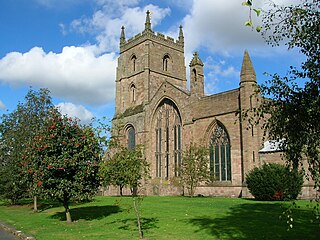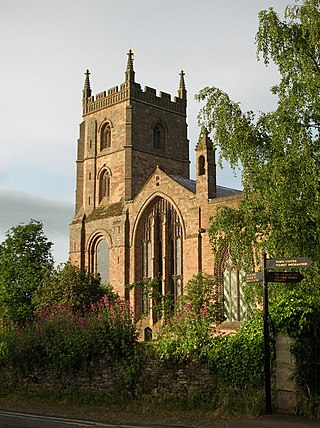Related Research Articles

Saint Guthlac of Crowland was a Christian hermit and saint from Lincolnshire in England. He is particularly venerated in the Fens of eastern England.

Crowland Abbey is a Church of England parish church, formerly part of a Benedictine abbey church, in Crowland in the English county of Lincolnshire. It is a Grade I listed building.
Westwood Priory was a priory of Benedictine nuns founded in 1153, near Droitwich, Worcestershire, England. It was a daughter house of Fontevraud Abbey, seized by the English crown in 1537 during the Dissolution of the monasteries.

The Priory Church is an Anglican parish church in Leominster, Herefordshire, England, dedicated to Saint Peter and Saint Paul. The building was constructed for a Benedictine Priory in about the 13th century, although there had been an Anglo-Saxon monastery in Leominster, possibly on the same site. In 1539 the east end of the church was destroyed along with most of the monastic buildings, but the main body of the church was preserved.

Leominster abbey was an Anglo-Saxon monastery established at Leominster in the county of Hereford, England. The name of the town refers to its minster, a settlement of clergy living a communal life.
Swavesey Priory was a medieval monastic house in the village of Swavesey, Cambridgeshire, England. A church existed in Swavesey at the time of the Norman Conquest, when Alan, Count of Richmond, granted it to the Benedictine Abbey of St Sergius and St Bacchus in Angers, France. The Abbey founded an alien priory in Swavesey by 1086. It ceased to function in 1539, during the dissolution of the monasteries. The site is now a scheduled monument.
Kilpeck Priory was a Benedictine priory in Kilpeck, Herefordshire, England, at grid reference SO448303.
Limebrook Priory was a priory in Lingen, Herefordshire, England at grid reference SO37386604.
Monkland Priory was a priory in Monkland, Herefordshire, England at grid reference SO46045768.

Shobdon Priory was a priory in Herefordshire, England at grid reference SO40106284.
Ocle Priory was a priory near Ocle Pychard in Herefordshire, England at grid reference SO577464. It was a dependency of Lyre Abbey in Normandy and as such an alien priory.
Boston Priory was a priory in Boston, Lincolnshire, England.

Deeping St James Priory was a priory in Deeping St James, Lincolnshire, England. It was a dependency of Thorney Abbey.

St Leonard's Priory, Stamford was a priory in Lincolnshire, England. It was built in Stamford, supposedly on the site of a monastery which was founded by St Wilfrid in 658 and destroyed in the Danish invasion.

The Benedictine Priory, King's Lynn, was a medieval monastery in Norfolk, England. It was founded in 1100 in King's Lynn by Herbert de Losinga, bishop of Norwich, as a small monastic house supporting the church of St Margaret founded at the same time. Its rents and profits were remitted for the use of the priory of the Holy Trinity which served Norwich Cathedral, also founded around the same time by Bishop Herbert. The priory at King's Lynn was lucrative for many years but towards the end of its existence the income from it had fallen to less than the cost of maintaining it.
Bromfield Priory was a priory in Shropshire, England, located at Bromfield near Ludlow.

Rumburgh Priory was a Benedictine priory located in the village of Rumburgh in the English county of Suffolk. The priory was founded in about 1065 as a cell of St Benet's Abbey at Hulme in Norfolk. At the time of the Domesday Book in 1086 it had 12 monks. The ownership of the priory was transferred to St Mary's Abbey in York towards the end of the 12th century. The monks of Rumburgh were particularly devoted to St. Bee, whom they commemorated at Michaelmas.

Atherstone Priory was a priory in Atherstone, Warwickshire, England.

Wolston Priory was a Benedictine priory near Wolston in Warwickshire, England. The earthwork remains of the priory are a Scheduled Ancient Monument. A present grade II* listed house is based on the remains of the rectory.
References
- 1 2 "St Guthlacs Priory". PastScape.org.uk. Historic England. Retrieved 19 December 2019.
- ↑ "St Guthlac's Priory". Herefordshire Through Time. Herefordshire Council. Archived from the original on 10 June 2011. Retrieved 19 September 2010.
- ↑ Plea Rolls of the Court of Common Pleas; in 1485; CP 40/891, seen : http://aalt.law.uh.edu/AALT3/R3/CP40no891/aCP40no891fronts/IMG_0450.htm
52°03′27″N2°42′25″W / 52.0576°N 2.707°W

